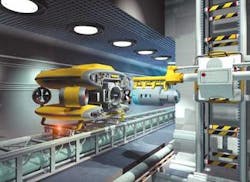Autonomous subsea technology expanding its role for future facilities
Graham Openshaw
Consultant
Ila Dawson
BP
Improved reliability with smarter tools
It is 1 a.m. on Jan. 25, 2009, and the facility has been operating without resident ROVs for more than a year now, but work continues around the clock and in any weather.
The Planned Maintenance System (PMS) interrogates the Production Control System to define the day's tasks. It notes that valves W23-4 and W23-5 are currently offline and can be cycled without affecting production activities, tasks that have been pending for a number of days.
It also notes that the well has not been imaged, acoustically profiled, or checked for corrosion protection for some time, and those tasks are added to the mission. The PMS sends the mission package to the Subsea Management System (SMS) and then continues with other planning and monitoring tasks.
The SMS sets up a full mission profile, including safe transit routes and exception handling procedures, and uploads the profile to a waiting autonomous underwater tool (AUT). The AUT picks up the appropriate torque tool end-effector from the tool rack and calibrates it to the range defined by the SMS.
Once the AUT verifies the mission profile with the SMS, the AUT runs pre-mission diagnostics. Confirming that all systems are operational, it launches via a subsurface deployment cursor.
Departing the structure 100 ft below the turbulent winter seas, the AUT navigates to the general area of W23 using inertial guidance. Once in the capture envelope for W23, real-time sonar image correlation verifies the theoretical location in the model world carried in the onboard navigation system. The AUT then moves down the safe corridor defined in the model until positioned in front of W23-4.
Using dynamic image recognition for local positioning, the AUT docks on W23-4 and verifies its location by reading the coding strip above the valve.
The AUT confirms the current valve status and verifies the mission with the SMS using low bandwidth, long-range acoustic telemetry. Receiving task confirmation, it cycles the valve twice, storing the torque profiles as it does so. The AUT repeats the process for W23-5. It then makes contact with the tree at a number of reference points to record an acoustic profile and corrosion protection reading. The AUT then moves to predetermined locations in front of each face of the tree to take reference images.
Mission complete, the AUT confirms its position in the spatial model and heads back to the platform where the subsea recovery system automatically picks it up. With the AUT back in its storage rack, the SMS uploads mission data to the PMS for review and evaluation. AUT diagnostics verify data integrity and tool calibration and also identify any maintenance requirements for the tool. With no anomalies identified the system recharges and readies for another mission.
The PMS uses trend-monitoring systems to identify a progressive change in the torque profile of W23-4 and flags the valve for closer monitoring. The reference images are digitally compared with previous images to detect any significant variation that might indicate a problem, such as corrosion or debris. The PMS then formats a summary report, including a set of images, in HTML and uploads it to the daily summary web site for review both on the facility and onshore.
While this mission has been active, a number of other tasks have been ongoing. An AUT is dimensionally checking and non-destructively testing anchor chain links, an infield flow-line is being monitored for heat buckling displacement, choke valve positions are being visually checked against indicated positions, and debris reported on a manifold is being videoed for future ROV intervention.
All of these activities are taking place under the direction of the PMS without human intervention. In fact, there are very few people remaining on the offshore facility. Most control is highly automated, and what human intervention is needed is provided from onshore facilities via high bandwidth communications. Remaining facility staff is predominantly associated with the few physical maintenance tasks on the topsides equipment.
This scenario may sound like science fiction, but it could be closer than we think. Autonomous underwater vehicles have already demonstrated the ability to carry out faster, less expensive seabed surveys, while delivering higher quality data. The focus is now turning to underwater inspection and intervention.
With increasing water depths, increasing step-out distances from host facilities, and with the growth in subsea processing, subsea systems are becoming discrete and complex production facilities in their own right. This development will significantly increase the need for a commercially effective approach to inspection, repair, and maintenance (IRM). Subsea intervention plays a critical part in this equation.
While IRM costs have an economic impact on all subsea developments, they are particularly critical for marginal or mature fields. If intervention costs increase, operators may abandon fields earlier than planned. Early abandonment could result in a significant reduction in recovery. As companies continually seek ways to manage opex, autonomous subsea technology (AST) offers the potential to improve operations performance and to improve overall economics.
The current cost for basic deepwater intervention in the Gulf of Mexico is between $35,000 and $50,000 per day. With mobilization, demobilization, and transit costs, it would be difficult to intervene on a typical GoM subsea system for less than $250,000. Normally, it will be substantially more. These costs can be twice as high elsewhere in the world.
Perhaps more importantly, the delay in being able to carry out such an intervention could be between two and seven days, depending on vessel availability. Without a full understanding of the problem at the time of intervention vessel charter, there is the likelihood of delays between the initial ROV observation and obtaining remediation equipment.
A facility-based autonomous vehicle has potential for providing early intervention in the event of a problem. The ability to respond rapidly to issues with detailed inspection and light intervention capability may eliminate some vessel operations entirely. Where a vessel operation is still needed, early knowledge obtained by the AUV may allow an accurate determination of the problem and equipment requirements, improving intervention effectiveness. This rapid response to issues is likely to reduce production losses and thus improve overall field economics.
A reduction in vessel days and improved intervention response time may be the more obvious benefit of AST, but more subtle impacts may reap greater rewards. One of the most significant benefits could be the change in IRM strategy. At present, the strategy is generally "intervene on failure." This is driven by the high cost of inspection, the lack of access to the facility, and a general lack of condition knowledge.
Improved system-condition monitoring, based on increased inspection, will facilitate a move toward proactive integrity management.
The Subsea Management System sets the mission profile for a waiting autonomous underwater tool.
Knowledge-based systems, employing sophisticated diagnostic and trend-monitoring tools, will process the additional information gathered. This will allow potential failures to be identified before they affect production and addressed with periodic and efficient campaign-based ROV operations.This proactive, knowledge-based, approach to IRM should improve system reliability while reducing costs.
The effective use of AST may allow engineers to radically rethink subsea facilities. Ubiquitous and low-cost physical access may reduce both the complexity and cost of ownership of subsea systems.
Maturing technology
The scenario described earlier could be carried out using currently available technology, but it has not yet matured. The gap is largely one of implementation. All of the pieces have to be brought together and effectively integrated into a commercially viable package. Many factors may have prevented this from happening. These factors affect both the client and the supplier communities.
Innovation can be supplier-driven, but demand-drive is a considerably stronger force. A lack of understanding of both the available technology and the potential opportunity, in part, fuels the lack of customer-based pressure to implement AST. Conventional practices are locked-in as a way of minimizing risk.
The tool runs pre-mission diagnostics and launches via a subsurface deployment cursor.
The potential benefits of a new approach have yet to be articulated effectively. Even where there is some understanding of the potential benefits, these are biased toward opex reduction. The ability to influence technical decisions occurs during the capex phase of projects, where there is less incentive to reduce opex and there is a natural aversion to risk. This stance will change as AST becomes mature, but it currently inhibits early implementation, as does the reasonable perception that the technology is still immature.
There are a number of issues that may inhibit supplier enthusiasm for this technology, probably the largest being perceived value. The organizations that would naturally be expected to initiate and sponsor new technology development currently obtain the bulk of their revenue from the supply of vessel platforms for ROV operations.
ROV equipment hire represents a relatively small portion of total earnings. The effective adoption of AST could be perceived as having a potentially negative impact on the bottom line. Adding to this, there is a strong sense that intervention products and services are now commodified to the extent that there is little incentive to innovate.
In this environment, developing and deploying new technology may be seen as having low returns and excessive risk.
The tool runs pre-mission diagnostics and launches via a subsurface deployment cursor.
Receiving task confirmation, the autonomous underwater tool cycles a wellhead valve twice and stores the torque profiles.
Forward movement
Given this development environment, what can be done to move this technology forward? Operators need to develop a clear commercial case for deploying AST, and, having assured themselves that it makes sense, show the vendor community that they are willing to reward such services effectively. As investment continues to increase in areas such as long tiebacks and subsea processing, the IRM component of the equation needs to receive sufficient early attention. At the same time, technology and service providers need to clearly demonstrate that this is viable operational technology and no longer the fodder of science fiction.
There are indications that these changes are starting to occur. BP is looking to fund at least one AST demonstration field trial by 2005 and is actively engaged in the Autotracker project, designed to autonomously track pipelines. BP and ConocoPhillips are supporting the Spinav (subsea planned inspection with an autonomous vehicle) project to autonomously inspect risers. Both of these projects are seen as precursors to intervention capability. Others are pursuing the potential use of hybrid AUV systems for intervention support. Both Eca and Cybernetix have demonstrated that AUVs can maneuver around structures and even dock autonomously. Once momentum builds, there is a bright future for autonomous subsea technology, with the potential for the underwater robotics industry to once again make a significant contribution to the continuing development of the oil and gas industry's capability.



